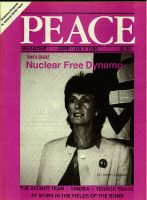
Peace Magazine Jun-Jul 1988, page 22. Some rights reserved.
Search for other articles by Metta Spencer here
The rolling hills between Vienna and Hungary are thick with villages. At the top of a hill, in a village of 2000 two hours' drive from Vienna, is a thirteenth century castle- Burg Schlaining, now being restored by the provincial government. A portion of it is becoming a museum and a pottery atelier is in full swing, providing jobs for mildly handicapped people. Two peace institutes are housed in the castle- one to provide teaching resources for secondary school peace education, the other for academic research. Jean Guy Vaillancourt and I have come as participant-observers to the founding at Burg Schlaining of the European University Centre for Peace Studies. Arriving early, we peer into windows of the library and classrooms, already nicely furnished. What a pleasant place to study! With professors and UNESCO officials from most other European countries, we are to create the university centre's legal statutes and the curriculum for its pilot semester. The Canadian UNESCO Commission wants our opinion on whether to join. By the end, we are ready to recommend that it do so.
The scholars easily reach consensus on a curriculum. Around the world, Peace Studies is developing into a distinctive academic discipline, with a common intellectual content. People from Hungary, Canada, Poland, the USSR, and Norway, for example, name the same top Peace scholars and assign many of the same books. In the United States, over 200 universities and colleges offer undergraduate programs in Peace Studies, and Europe is seemingly keeping up with that trend.
UNESCO plans to start the Schlaining program in the fall of 1990 by bringing together thirty or more graduate students -equally from the East and the West. North America is counted as part of UNESCO's European section, 50 Canadian and American students and professors are welcome. Courses will be in English. The organization's members will be national commissions for UNESCO, universities, institutes, and even individual scholars. Eventually Schlaining will grant Ph.D. degrees in Peace Studies, though this goal is probably far away -- if, indeed, it can be attained at all. More likely, Ph.Ds can be offered in a program of collaboration with member universities.
SCHLAINING'S MINUSES ARE OBVIOUS: its remoteness and inaccessibility to good libraries. UNESCO will give it a library, and a computer will link it to the University of Vienna's catalog, with a delivery service. This will suffice for course work, but not for independent research at the doctoral level.
Schlaining's plus, however, will more than offset this disadvantage: Close contact will be possible between Eastern and Western participants. The Eastern delegates were impressive. Some of the socialist countries are more advanced in their "restructuring" than others -- Hungary being notably open. (Today, for example, Hungarians who have the money for foreign travel can do so without restrictions.) The only ideologically significant remark that I heard was an objection by a Hungarian professor to the term "bourgeois peace research," which appeared in a draft text. "Research is research!" he declared. "There is no such thing as 'bourgeois' peace research!" He echoed by the leading Soviet delegate, the newly-appointed Pro-rector of the Soviet Diplomatic Academy. Accordingly a more neutral term was substituted.
All discussions with this new Pro-rector, incidentally, showed Soviet "new thinking." Now in charge of training Soviet foreign service officers and organizing Soviet foreign policy research, he was chosen for his policy-leanings. I liked his wise and liberal policies on European and Arctic security questions. His sending students and faculty to Schlaining will keep it stimulating.
It is premature to apply for a place in Schlaining, but nevertheless I have received inquiries. Instead of writing to me or Professor Vaillancourt, write to Herr Gerald Mader, European University Centre for Peace Studies, Schlaining, Austria

Peace Magazine Jun-Jul 1988, page 22. Some rights reserved.
Search for other articles by Metta Spencer here